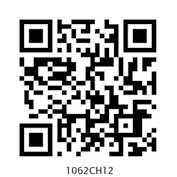Table of Contents
12
Areas Related to Circles
12.1 Introduction
You are already familiar with some methods of finding perimeters and areas of simple plane figures such as rectangles, squares, parallelograms, triangles and circles from your earlier classes. Many objects that we come across in our daily life are related to the circular shape in some form or the other. Cycle wheels, wheel barrow (thela), dartboard, round cake, papad, drain cover, various designs, bangles, brooches, circular paths, washers, flower beds, etc. are some examples of such objects (see Fig. 12.1). So, the problem of finding perimeters and areas related to circular figures is of great practical importance. In this chapter, we shall begin our discussion with a review of the concepts of perimeter (circumference) and area of a circle and apply this knowledge in finding the areas of two special ‘parts’ of a circular region (or briefly of a circle) known as sector and segment. We shall also see how to find the areas of some combinations of plane figures involving circles or their parts.

Fig. 12.1
12.2 Perimeter and Area of a Circle — A Review
Recall that the distance covered by travelling once around a circle is its perimeter, usually called its circumference. You also know from your earlier classes, that circumference of a circle bears a constant ratio with its diameter. This constant ratio is denoted by the Greek letter π (read as ‘pi’). In other words,
 = π
= π
or, circumference = π × diameter
= π × 2r (where r is the radius of the circle)
= 2πr
The great Indian mathematician Aryabhata (C.E. 476 – 550) gave an approximate value of π. He stated that π =  which is nearly equal to 3.1416. It is also interesting to note that using an identity of the great mathematical genius Srinivas Ramanujan (1887–1920) of India, mathematicians have been able to calculate the value of π correct to million places of decimals. As you know from Chapter 1 of
which is nearly equal to 3.1416. It is also interesting to note that using an identity of the great mathematical genius Srinivas Ramanujan (1887–1920) of India, mathematicians have been able to calculate the value of π correct to million places of decimals. As you know from Chapter 1 of
Class IX, π is an irrational number and its decimal expansion is non-terminating and non-recurring (non-repeating). However, for practical purposes, we generally take the value of π as  or 3.14, approximately.
or 3.14, approximately.
You may also recall that area of a circle is πr2, where r is the radius of the circle. Recall that you have verified it in Class VII, by cutting a circle into a number of sectors and rearranging them as shown in Fig. 12.2.

Fig 12.2
You can see that the shape in Fig. 12.2 (ii) is nearly a rectangle of length  and breadth r. This suggests that the area of the circle =
and breadth r. This suggests that the area of the circle =  × 2πr × r = πr2. Let us recall the concepts learnt in earlier classes, through an example.
× 2πr × r = πr2. Let us recall the concepts learnt in earlier classes, through an example.
Example 1 :
The cost of fencing a circular field at the rate of ` 24 per metre is
` 5280. The field is to be ploughed at the rate of ` 0.50 per m2. Find the cost of ploughing the field (Take π =  ).
).
Solution :
Length of the fence (in metres) =  =
= 
So, circumference of the field = 220 m
Therefore, if r metres is the radius of the field, then
2πr = 220
or, 2 ×  × r = 220
× r = 220
or, r =  = 35
= 35
i.e., radius of the field is 35 m.
Therefore, area of the field = πr2 =  × 35 × 35 m2 = 22 × 5 × 35 m2
× 35 × 35 m2 = 22 × 5 × 35 m2
Now, cost of ploughing 1 m2 of the field = rupee 0.50
So, total cost of ploughing the field = rupee 22 × 5 × 35 × 0.50 = rupee 1925
Exercise 12.1
Unless stated otherwise, use π =  .
.
1. The radii of two circles are 19 cm and 9 cm respectively. Find the radius of the circle which has circumference equal to the sum of the circumferences of the two circles.
2. The radii of two circles are 8 cm and 6 cm respectively. Find the radius of the circle having area equal to the sum of the areas of the two circles.

Fig. 12.3
3. Fig. 12.3 depicts an archery target marked with its five scoring regions from the centre outwards as Gold, Red, Blue, Black and White. The diameter of the region representing Gold score is 21 cm and each of the other bands is 10.5 cm wide. Find the area of each of the five scoring regions.
4. The wheels of a car are of diameter 80 cm each. How many complete revolutions does each wheel make in 10 minutes when the car is travelling at a speed of 66 km per hour?
5. Tick the correct answer in the following and justify your choice : If the perimeter and the area of a circle are numerically equal, then the radius of the circle is
(A) 2 units (B) π units (C) 4 units (D) 7 units
12.3 Areas of Sector and Segment of a Circle

Fig. 12.4
You have already come across the terms sector and segment of a circle in your earlier classes. Recall that the portion (or part) of the circular region enclosed by two radii and the corresponding arc is called a sector of the circle and the portion (or part) of the circular region enclosed between a chord and the corresponding arc is called a segment of the circle. Thus, in Fig. 12.4, shaded region OAPB is a sector of the circle with centre O. ∠ AOB is called the angle of the sector. Note that in this figure, unshaded region OAQB is also a sector of the circle. For obvious reasons, OAPB is called the minor sector and OAQB is called the major sector. You can also see that angle of the major sector is 360° – ∠ AOB.
Now, look at Fig. 12.5 in which AB is a chord of the circle with centre O. So, shaded region APB is a segment of the circle. You can also note that unshaded region AQB is another segment of the circle formed by the chord AB. For obvious reasons, APB is called the minor segment and AQB is called the major segment.

Fig. 12.5
Remark :
When we write ‘segment’ and ‘sector’ we will mean the ‘minor segment’ and the ‘minor sector’ respectively, unless stated otherwise.
Now with this knowledge, let us try to find some relations (or formulae) to calculate their areas.
Let OAPB be a sector of a circle with centre O and radius r (see Fig. 12.6). Let the degree measure of ∠ AOB be θ.

Fig. 12.6
You know that area of a circle (in fact of a circular region or disc) is πr2.
In a way, we can consider this circular region to be a sector forming an angle of 360° (i.e., of degree measure 360) at the centre O. Now by applying the Unitary Method, we can arrive at the area of the sector OAPB as follows:
When degree measure of the angle at the centre is 360, area of the sector = πr2
So, when the degree measure of the angle at the centre is 1, area of the sector = 
Therefore, when the degree measure of the angle at the centre is θ, area of the sector =  =
=  .
.
Thus, we obtain the following relation (or formula) for area of a sector of a circle:
Area of the sector of angle θ = ,
,
where r is the radius of the circle and θ the angle of the sector in degrees.

Fig. 12.7
Now, a natural question arises : Can we find the length of the arc APB corresponding to this sector? Yes. Again, by applying the Unitary Method and taking the whole length of the circle (of angle 360°) as 2πr, we can obtain the required length of the arc APB as  .
.
So, length of an arc of a sector of angle θ =  .
.
Now let us take the case of the area of the segment APB of a circle with centre O and radius r (see Fig. 12.7). You can see that :
Area of the segment APB = Area of the sector OAPB – Area of ∆ OAB
= 
Note :
From Fig. 12.6 and Fig. 12.7 respectively, you can observe that :
Area of the major sector OAQB = πr2 – Area of the minor sector OAPB
and Area of major segment AQB = πr2 – Area of the minor segment APB
Let us now take some examples to understand these concepts (or results).
Example 2 :
Find the area of the sector of a circle with radius 4 cm and of angle 30°. Also, find the area of the corresponding major sector (Use π = 3.14).
Solution :
Given sector is OAPB (see Fig. 12.8).
Area of the sector = 
= 
=  (approx.)
(approx.)
Area of the corresponding major sector

Fig. 12.8
= πr2 – area of sector OAPB
= (3.14 × 16 – 4.19) cm2
= 46.05 cm2 = 46.1 cm2(approx.)
Alternatively, area of the major sector = 
= 
= 
= 46.1 cm2 (approx.)
Example 3 :
Find the area of the segment AYB shown in Fig. 12.9, if radius of the circle is 21 cm and ∠ AOB = 120°. (Use π =  )
)

Fig. 12.9
Solution :
Area of the segment AYB
= Area of sector OAYB – Area of ∆ OAB (1)
Now, area of the sector OAYB =  cm2 = 462 cm2 (2)
cm2 = 462 cm2 (2)
For finding the area of ∆ OAB, draw OM ⊥ AB as shown in Fig. 12.10.
Note that OA = OB. Therefore, by RHS congruence, ∆ AMO ≅ ∆ BMO.
So, M is the mid-point of AB and ∠ AOM = ∠ BOM =  .
.
Let OM = x cm
So, from ∆ OMA,  = cos 60°
= cos 60°

Fig. 12.10
or,  =
= 
or, x = 
So, OM =  cm
cm
Also,  = sin 60° =
= sin 60° = 
So, AM =  cm
cm
Therefore, AB = 2 AM = 
So, area of ∆ OAB =  =
= 
=  (3)
(3)
Therefore, area of the segment AYB =  [From (1), (2) and (3)]
[From (1), (2) and (3)]
= 
Exercise 12.2
Unless stated otherwise, use π =  .
.
1. Find the area of a sector of a circle with radius 6 cm if angle of the sector is 60°.
2. Find the area of a quadrant of a circle whose circumference is 22 cm.
3. The length of the minute hand of a clock is 14 cm. Find the area swept by the minute hand in 5 minutes.
4. A chord of a circle of radius 10 cm subtends a right angle at the centre. Find the area of the corresponding : (i) minor segment (ii) major sector. (Use π = 3.14)
5. In a circle of radius 21 cm, an arc subtends an angle of 60° at the centre. Find:
(i) the length of the arc (ii) area of the sector formed by the arc
(iii) area of the segment formed by the corresponding chord
6. A chord of a circle of radius 15 cm subtends an angle of 60° at the centre. Find the areas of the corresponding minor and major segments of the circle.
(Use π = 3.14 and  = 1.73)
= 1.73)
7. A chord of a circle of radius 12 cm subtends an angle of 120° at the centre. Find the area of the corresponding segment of the circle.
(Use π = 3.14 and  = 1.73)
= 1.73)
8. A horse is tied to a peg at one corner of a square shaped grass field of side 15 m by means of a 5 m long rope (see Fig. 12.11). Find
(i) the area of that part of the field in which the horse can graze.
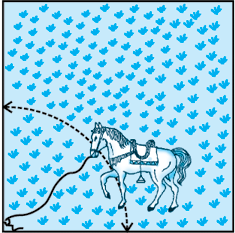
(ii) the increase in the grazing area if the rope were 10 m long instead of 5 m. (Use π = 3.14)
9. A brooch is made with silver wire in the form of a circle with diameter 35 mm. The wire is also used in making 5 diameters which divide the circle into 10 equal sectors as shown in Fig. 12.12. Find :
(i) the total length of the silver wire required.
(ii) the area of each sector of the brooch.

Fig. 12.12
10. An umbrella has 8 ribs which are equally spaced (see Fig. 12.13). Assuming umbrella to be a flat circle of radius 45 cm, find the area between the two consecutive ribs of the umbrella.
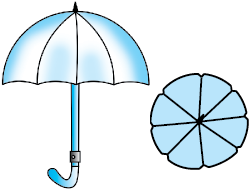
Fig. 12.13
11. A car has two wipers which do not overlap. Each wiper has a blade of length 25 cm sweeping through an angle of 115°. Find the total area cleaned at each sweep of the blades.
12. To warn ships for underwater rocks, a lighthouse spreads a red coloured light over a sector of angle 80° to a distance of 16.5 km. Find the area of the sea over which the ships are warned. (Use π = 3.14)
13. A round table cover has six equal designs as shown in Fig. 12.14. If the radius of the cover is 28 cm, find the cost of making the designs at the rate of
` 0.35 per cm2. (Use  = 1.7)
= 1.7)
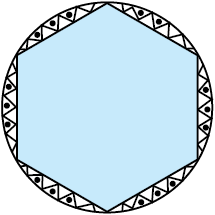
Fig. 12.14
14. Tick the correct answer in the following :
Area of a sector of angle p (in degrees) of a circle with radius R is
(A)  (B)
(B)  (C)
(C)  (D)
(D) 
12.4 Areas of Combinations of Plane Figures
So far, we have calculated the areas of different figures separately. Let us now try to calculate the areas of some combinations of plane figures. We come across these types of figures in our daily life and also in the form of various interesting designs. Flower beds, drain covers, window designs, designs on table covers, are some of such examples. We illustrate the process of calculating areas of these figures through some examples.
Example 4 :
In Fig. 12.15, two circular flower beds have been shown on two sides of a square lawn ABCD of side 56 m. If the centre of each circular flower bed is the point of intersection O of the diagonals of the square lawn, find the sum of the areas of the lawn and the flower beds.
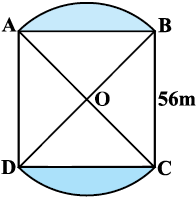
Fig. 12.15
Solution :
Area of the square lawn ABCD = 56 × 56 m2 (1)
Let OA = OB = x metres
So, x2 + x2 = 562
or, 2x2 = 56 × 56
or, x2 = 28 × 56 (2)
Now, area of sector OAB =  =
= 
=  [From (2)] (3)
[From (2)] (3)
Also, area of ∆ OAB =  (∠ AOB = 90°) (4)
(∠ AOB = 90°) (4)
So, area of flower bed AB = 
[From (3) and (4)]
= 
=  (5)
(5)
Similarly, area of the other flower bed
=  (6)
(6)
Therefore, total area = 
 [From (1), (5) and (6)]
[From (1), (5) and (6)]
= 
= 
Alternative Solution :
Total area = Area of sector OAB + Area of sector ODC
+ Area of ∆ OAD + Area of ∆ OBC
= 

= 
= 
= 56 × 72 m2 = 4032 m2
Example 5 :
Find the area of the shaded region in Fig. 12.16, where ABCD is a square of side 14 cm.
Solution :
Area of square ABCD
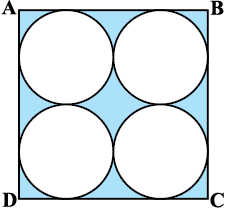
Fig. 12.16
= 14 × 14 cm2 = 196 cm2
Diameter of each circle = 
So, radius of each circle = 
So, area of one circle = πr2 = 
= 
Therefore, area of the four circles = 
Hence, area of the shaded region = (196 – 154) cm2 = 42 cm2.
Example 6 :
Find the area of the shaded design in Fig. 12.17, where ABCD is a square of side 10 cm and semicircles are drawn with each side of the square as diameter. (Use π = 3.14)
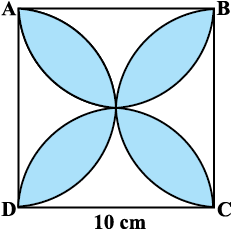
Fig. 12.17
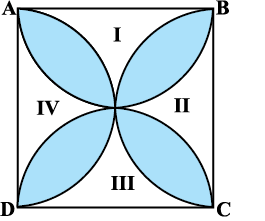
Fig. 12.18
Solution :
Let us mark the four unshaded regions as I, II, III and IV (see Fig. 12.18).
Area of I + Area of III
=  = (100 – 3.14 × 25) cm2
= (100 – 3.14 × 25) cm2
= (100 – 78.5) cm2 = 21.5 cm2
Similarly, Area of II + Area of IV = 21.5 cm2
So, area of the shaded design = Area of ABCD – Area of (I + II + III + IV)
= (100 – 2 × 21.5) cm2 = (100 – 43) cm2 = 57 cm2
Exercise 12.3
Unless stated otherwise, use π = 
1. Find the area of the shaded region in Fig. 12.19, if PQ = 24 cm, PR = 7 cm and O is the centre of the circle.
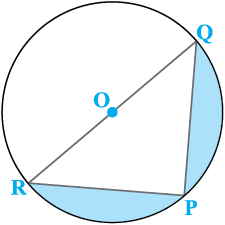
Fig. 12.19
2. Find the area of the shaded region in Fig. 12.20, if radii of the two concentric circles with centre O are 7 cm and 14 cm respectively and ∠ AOC = 40°.
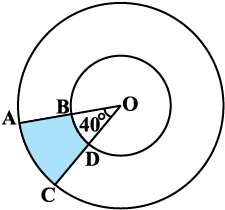
Fig. 12.20
3. Find the area of the shaded region in Fig. 12.21, if ABCD is a square of side 14 cm and APD and BPC are semicircles.
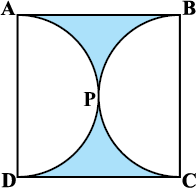
Fig. 12.21
4. Find the area of the shaded region in Fig. 12.22, where a circular arc of radius 6 cm has been drawn with vertex O of an equilateral triangle OAB of side 12 cm as centre.

Fig. 12.22
5. From each corner of a square of side 4 cm a quadrant of a circle of radius 1 cm is cut and also a circle of diameter 2 cm is cut as shown in Fig. 12.23. Find the area of the remaining portion of the square.
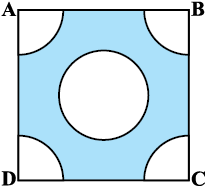
Fig. 12.23
6. In a circular table cover of radius 32 cm, a design is formed leaving an equilateral triangle ABC in the middle as shown in Fig. 12.24. Find the area of the design.
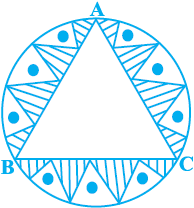
Fig. 12.24
7. In Fig. 12.25, ABCD is a square of side 14 cm. With centres A, B, C and D, four circles are drawn such that each circle touch externally two of the remaining three circles. Find the area of the shaded region.
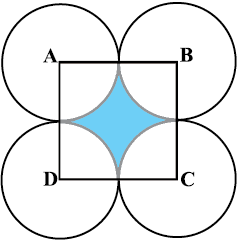
Fig. 12.25
8. Fig. 12.26 depicts a racing track whose left and right ends are semicircular.

Fig. 12.26
The distance between the two inner parallel line segments is 60 m and they are each 106 m long. If the track is 10 m wide, find :
(i) the distance around the track along its inner edge
(ii) the area of the track.
9. In Fig. 12.27, AB and CD are two diameters of a circle (with centre O) perpendicular to each other and OD is the diameter of the smaller circle. If OA = 7 cm, find the area of the shaded region.
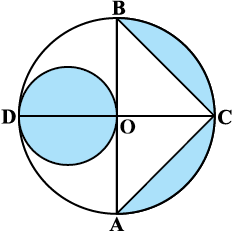
Fig. 12.27
10. The area of an equilateral triangle ABC is 17320.5 cm2. With each vertex of the triangle as centre, a circle is drawn with radius equal to half the length of the side of the triangle (see Fig. 12.28). Find the area of the shaded region. (Use π = 3.14 and  = 1.73205)
= 1.73205)
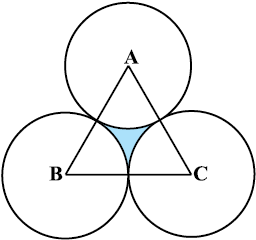
Fig. 12.28
11. On a square handkerchief, nine circular designs each of radius 7 cm are made
(see Fig. 12.29). Find the area of the remaining portion of the handkerchief.
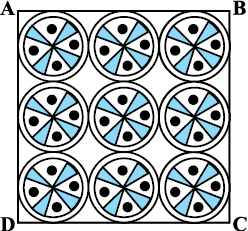
Fig. 12.29
12. In Fig. 12.30, OACB is a quadrant of a circle with centre O and radius 3.5 cm. If OD = 2 cm, find the area of the
(i) quadrant OACB, (ii) shaded region.
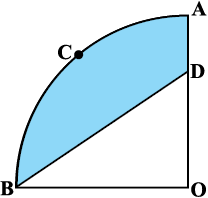
Fig. 12.30
13. In Fig. 12.31, a square OABC is inscribed in a quadrant OPBQ. If OA = 20 cm, find the area of the shaded region. (Use π = 3.14)
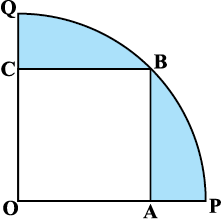
Fig. 12.31
14. AB and CD are respectively arcs of two concentric circles of radii 21 cm and 7 cm and centre O (see Fig. 12.32). If ∠ AOB = 30°, find the area of the shaded region.

Fig. 12.32
15. In Fig. 12.33, ABC is a quadrant of a circle of radius 14 cm and a semicircle is drawn with BC as diameter. Find the area of the shaded region.
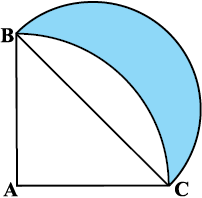
Fig. 12.33
16. Calculate the area of the designed region in Fig. 12.34 common between the two quadrants of circles of radius 8 cm each.
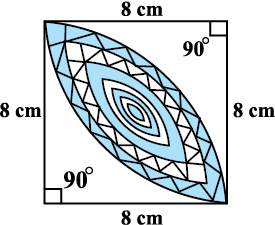
Fig. 12.34
12.5 Summary
In this chapter, you have studied the following points :
1. Circumference of a circle = 2 π r.
2. Area of a circle = π r2.
3. Length of an arc of a sector of a circle with radius r and angle with degree measure θ is 
4. Area of a sector of a circle with radius r and angle with degree measure θ is 
5. Area of segment of a circle
= Area of the corresponding sector – Area of the corresponding triangle.
